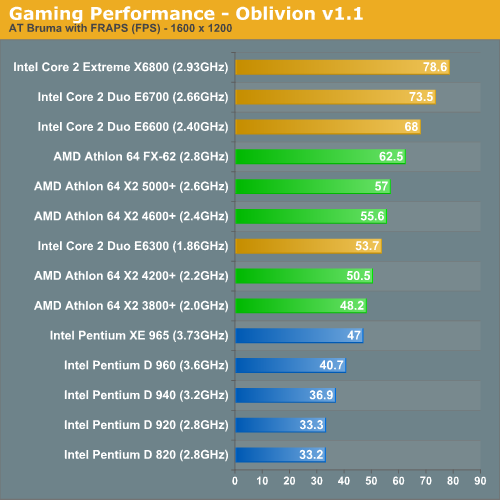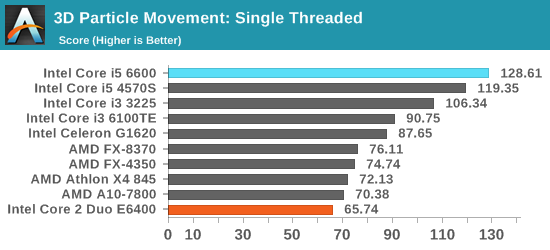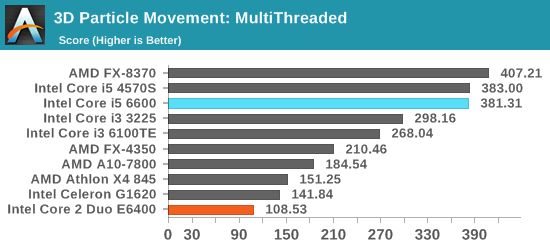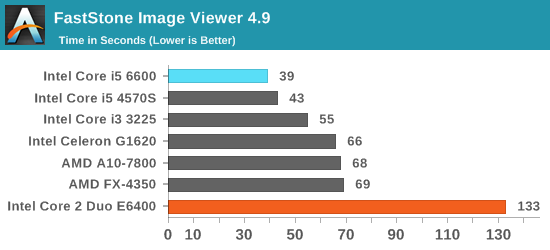Ten Year Anniversary of Core 2 Duo and Conroe: Moore’s Law is Dead, Long Live Moore’s Law
by Ian Cutress on July 27, 2016 10:30 AM EST- Posted in
- CPUs
- Intel
- Core 2 Duo
- Conroe
- ITRS
- Nostalgia
- Time To Upgrade
Core: Performance vs. Today
Looking back at Anand’s original review, and at a time where CPU performance made a lot of difference for gaming frame rates at 1600x1200, the conclusion was quite startling.
Intel's Core 2 Extreme X6800 didn't lose a single benchmark in our comparison; not a single one. In many cases, the $183 Core 2 Duo E6300 actually outperformed Intel's previous champ: the Pentium Extreme Edition 965. In one day, Intel has made its entire Pentium D lineup of processors obsolete.

Imagine something like that happening today. (Actually, if you believe what we’ve been told, AMD’s upcoming AM4 platform with Zen and Bristol Ridge might make its current desktop platform obsolete, but that’s a slightly different discussion because of how integrated graphics has adjusted the landscape for CPU focused silicon somewhat.)
That’s Intel vs. Intel though, against AMD it was just as damning.
Compared to AMD's Athlon 64 X2 the situation gets a lot more competitive, but AMD still doesn't stand a chance. The Core 2 Extreme X6800, Core 2 Duo E6700 and E6600 were pretty consistently in the top 3 or 4 spots in each benchmark, with the E6600 offering better performance than AMD's FX-62 flagship in the vast majority of benchmarks.
However, Core 2 Duo has now been out for 10 years. I’ve pulled up some benchmark data from our database to see if we have any matches to compare against processors that cost $214 today. The Core i5-6600 fits our bill perfectly, and there are two benchmarks which match up. I’ve also dotted the graphs with a range of more recent AMD and Intel processors for progression.



Our 3D Particle Movement is more for idealized synthetic workloads, however FastStone is all about image conversion and favors high frequency, high single threaded performance.
Naturally, modern processors nearing 4.00 GHz have a large advantage over the 2.13 GHz version of Core 2 Duo, as well as multiple generations of improved microarchitecture designs and smaller lithography nodes for power efficiency. However, has any processor family had as much nostalgic longevity as the consumer launch of Core? One could argue that while Core put Intel on top of the heap again, Sandy Bridge was a more important shift in design and as a result, many users went from Conroe to Sandy Bridge and have stayed there.










158 Comments
View All Comments
Namisecond - Thursday, July 28, 2016 - link
NVMe may not be all it's cracked up to be. It, for the most part, limits you to booting windows 8 and higher, and good luck with the free upgrade to windows 10 (which supposedly ends tomorrow).FourEyedGeek - Monday, August 8, 2016 - link
Same CPU here, mine is running at 4Ghz, I can't see a reason other than NVMe to upgrade.dotwayne - Thursday, July 28, 2016 - link
Had a trusty E6300 @ 3.4-5 ghz back then. ahhh...miss those days of oc-ing the shit out of these cheap but super capable silicons.jamyryals - Thursday, July 28, 2016 - link
Neat article, I enjoyed it Ian!azazel1024 - Thursday, July 28, 2016 - link
Yeah a lot of those assumptions and guestimates for the future seem either overly optimistic or seem to ignore realities. I realize board power doesn't equate to average power use, but you are still talking about max power consumption that would drain a current cell phone battery dead in less than an hour, even on some of the biggest phone batteries.Beyond that is the heat dissipation, that phone is going to get mighty hot trying to dissipate 8+ watts out of even a large phone chassis.
As pointed out, 32 cores seems a wee excessive. A lot of it seems to be "if we take it to the logical extreme" as opposed to "what we think is likely".
Peichen - Thursday, July 28, 2016 - link
Take a 45nm C2Q Q9650 ($50 eBay), overclock to 4.0GHz, and you will be as fast as AMD's FX-9590 that's running at 220W. Older motherboard and DDR2 will be harder to come by but it is sad how AMD never managed to catch up to Core 2 after all these years. E6400 was my first Intel after switching to AMD after the original Pentium and I have never look back at AMD again.Panoramix0903 - Thursday, July 28, 2016 - link
I have made an upgrade from C2D 6550 to Q9650 in my old DELL Optiplex 755 MT. Plus 4x 2GB DDR2 800 MHz, Intel 535 SSD 240 GB, Sapphire Radeon HD7750 1GB DDR5, Sound Blaster X-FI, and USB 3.0 PCI-E card. Running Windows 7 Professional. 3-times more power then original DELL configuration :-)JohnRO - Thursday, July 28, 2016 - link
I just logged in to tell you that I'm reading this article on my desktop PC which has a Intel Core 2 Duo E4300 processor (1,8 GHz, 200 MHz FSB) with 4 GB of RAM (started with 2). When I wanted (or needed) I overclocked this processor to 3 GHz (333 MHz FSB).My PC will have its 10 years anniversary this December. During the years I upgraded the video card (for 1080p h264 hardware decoding and games when I still played them) and added more hard drives. The PC has enough performance for what I’m using it right now – so I would say that this is a good processor.
siriq - Thursday, July 28, 2016 - link
I still got my mobile 2600+ barton @2750 mhz , 939 3800+ x2 @2950 mhz . They were awesome!althaz - Thursday, July 28, 2016 - link
I bought a C2D E6300 the week it came out, my first Intel CPU since 2000. My previous CPUs had been an AMD Athlon 64 and an AMD Athlon Thunderbird.That E6300 remains my all-time favourite CPU. It's still running in a friend of mine's PC (@ 2.77Ghz, which I overclocked it to soon after getting it). It was just *so* fast compared to my old PC. Everything just instantly got faster (and I hadn't even upgraded my GPU!).